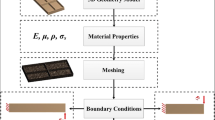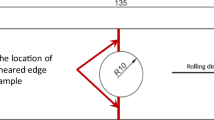Abstract
This work provides numerical and experimental investigations of blanking process, where the shear-enhanced Lemaitre’s damage model is fully characterized and successfully applied in blanking process to predict the cutting force and cutting edge geometry under different blanking process parameters. Advanced high strength steel DP1000 and an aluminum alloy Al6082-T6 are selected for series of experiments. To obtain the damage parameters in Lemaitre’s damage model the flat rectangular notched specimens tensile test was conducted and the inverse parameter identification procedure was performed. For characterizing the crack closure parameter h in the shear enhanced Lemaitre’s damage model, an in-plane torsion test with novel specimen design was conducted. The finite element model (FEM) of this test was established with the minimum mesh size of 0.01 mm which was consistent with the minimum mesh size in the shear zone of the FEM for blanking process simulation. The longitudinal strain distributions of four kinds of initial notch radius or central-hole specimen were measured and compared with simulation results to validate the FEMs for these four tests. Deformation analysis of blanking of a circular work piece also was performed under three clearances. The effects of blanking conditions on sheared part morphology were detected. Stress triaxiality distribution of the blank sheet was revealed taking advantage of the successfully established FEM. The availability of the testing method and the determination method of the parameters was investigated.
















Similar content being viewed by others
References
Dixit PM, Dixit US (2008) Modeling of metal forming and machining processes. Springer, Berlin
Chang TM, Swift HW (1950) Shearing of metalbars. J Inst Met 78:119–146
Taupin E, Breitling J, Wu WT et al (1996) Material fracture and burr formation in blanking results of FEM simulations and comparison with experiments. J Mater Process Technol 59(1/2):68–78
Hambli R, Poitiron A (2000) Finite element modeling of sheet-metal blanking operations with experimental verification. J Mater Process Technol 102(1/3):257–265
Hambli R (2001) Comparison between Lemaitre and Gurson damage models in crack growth simulation during blanking process. Int J Mech Sci 43:2769–2790
Goijaerts AM, Govaert LE, Baaijens FPT (2001) Evaluation of ductile fracture models for different metals in blanking. J Mater Process Technol 110:312–323
Hambli R (2002) Prediction of burr height formation in blanking processes using neural network. Int J Mech Sci 44:2089–2102
Rachik M, Roelandt JM, Maillard A (2002) Some phenomenological and computational aspects of sheet metal blanking simulation. J Mater Process Technol 128:256–265
Farzin M, Javani HR, Mashayekhi M et al (2006) Analysis of blanking process using various damage criteria. J Mater Process Technol 177:287–290
Gram MD, Wagoner RH (2011) Fine blanking of high strength steels: control of material properties for tool life. J Mater Process Technol 211:717–728
Saanouni K, Belamri N, Autesserre P (2010) Finite element simulation of 3D sheet metal guillotining using advanced fully coupled elastoplastic-damage constitutive equations. Finite Elem Anal Des 46:535–550
Lemaitre J (1996) Course on damage mechanics. Springer, Berlin
Soyarslan C, Tekkaya AE, Akyuz U (2008) Application of continuum damage mechanics in discontinuous crack formation: forward extrusion chevron predictions. Z Angew Math Mech 88(6):436–453
Tekkaya AE, Allwood JM, Bariani PF et al (2015) Metal forming beyond shaping: predicting and setting product properties. CIRP Ann Manuf Technol 64(2):629–653
Gachet JM, Delattre G, Bouchard PO (2015) Improved fracture criterion to chain forming stage and in use mechanical strength computations of metallic parts—application to half-blanked components. J Mater Process Technol 216:260–277
Dalloz A, Besson J, Gourgues-Lorenzon AF et al (2009) Effect of shear cutting on ductility of a dual phase steel. Eng Fract Mech 76:1411–1424
Isik K, Doig M, Richter H et al (2012) Enhancement of Lemaitre model to predict cracks at low and negative triaxialities in sheet metal forming. Key Eng Mater 639:427–434
Bao Y, Wierzbicki T (2004) On fracture locus in the equivalent strain and stress triaxiality space. Int J Mech Sci 46(1):81–98
Soyarslan C, Gharbi MM, Tekkaya AE (2012) A combined experimental-numerical investigation of ductile fracture in bending of a class of ferritic-martensitic steel. Int J Solids Struct 49:1608–1626
Bonora N, Gentile D, Pirondi A et al (2005) Ductile damage evolution under triaxial state of stress: theory and experiments. Int J Plast 21:981–1007
VDI 2906-2 (1994) Quality of cut faces of (sheet) metal parts after cutting, blanking, trimming or piercing. Verein Deutscher Ingenieure, Düsseldorf, Beuth Verlag, Berlin
Wu X, Bahmanpour H, Schmid K (2012) Characterization of mechanically sheared edges of dual phase steels. J Mater Process Technol 212:1209–1224
Tekiner Z, Nalbant M, Gürün H (2006) An experimental study for the effect of different clearances on burr, smooth-sheared and blanking force on aluminium sheet metal. Mater Des 27:1134–1138
Çavuşoğlu O, Gürün H (2017) The relationship of burr height and blanking force with clearance in the blanking process of AA5754 aluminium alloy. Trans Famena 41:55–62
Behrens BA, Bouguecha A, Vucetic M et al (2014) Numerical and experimental determination of cut-edge after blanking of thin steel sheet of DP1000 within use of stress based damage model. Proc Eng 81:1096–1101
Acknowledgements
The authors would like to acknowledge the support provided by the German Academic Exchange Service (DAAD).
Author information
Authors and Affiliations
Corresponding author
Rights and permissions
About this article
Cite this article
Cai, S., Chen, L. Parameter identification and blanking simulations of DP1000 and Al6082-T6 using Lemaitre damage model. Adv. Manuf. 9, 457–472 (2021). https://doi.org/10.1007/s40436-021-00350-5
Received:
Revised:
Accepted:
Published:
Issue Date:
DOI: https://doi.org/10.1007/s40436-021-00350-5




